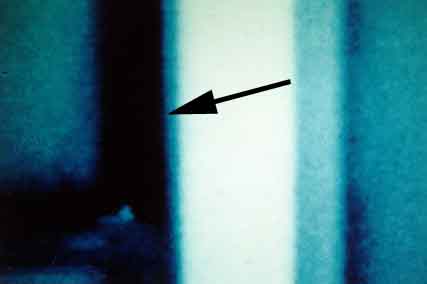MILDEW, A RESULT OF EXCESSIVE MOISTURE IN A BUILDING
by
Charles C. Roberts, Jr.
Mildew is a blackish looking area on building surfaces produced
by a variety of molds. Molds, elementary plants known as fungi,
are typically in the air and thrive in moist, warm, dark, and
stagnant air conditions. Molds in buildings most often form on
leather, wood, paper, cotton and other materials that act as a food
source. Figure 1 is a view of a typical window frame showing
mold growth. The arrow points to areas where condensation has

Figure 1

Figure 2
been occurring from a poorly designed thermal barrier in a window
system. Figure 2 is an infrared thermogram of the area. In the
thermogram, light shades are warm while dark shades are cold.
The arrow points to a very cold area along the frame where a
poorly designed thermal break was installed. Typically a thermal
break reduces cold transfer from the outside so there is no
condensation on the window surfaces. In this case, there is
excessive cold transfer to the inside, causing condensation and
mold growth. Figure 3 is a view of a typical sliding door with a
damaged door seal. The infiltrating air has caused cooling of the
door frame area and resulting condensation. The moist

Figure 3

Figure 4
environment sets up the mold growth from mold spores in the air.
Figure 4 shows a swimming pool room addition to a home. During
the first winter, severe mold growth was noted at the corners of the
room as indicated by the arrows. Typically, it is difficult to insulate
the corners of frame construction. This results in cold areas along
the corners, promoting moisture condensation from the moisture-
laden air in the pool room, an important ingredient in mold
evolution. Figure 5 is a view of a wall stud with evidence of mold
at the bottom, as a result of a continually flooding basement.

Figure 5
The environment for mold or mildew growth is excessive moisture,
reduced lighting, insufficient air circulation, warm conditions and
surface type. Reducing mold growth entails removing several
characteristics of the environment. Dehumidification, increased air
circulation, cleaning of surfaces and chemical treatment are steps
that can be taken to reduce mildew or mold growth. Without
remedying the mold problem, damage to surfaces can occur over
time requiring repainting or replacement.
FOR TECHNICAL ARTICLES CONTACT CLAIMS MAGAZINE AND ASK
FOR A REPRINT OF A PAST TECHNICAL NOTEBOOK ARTICLE
CLAIMS MAGAZINE




